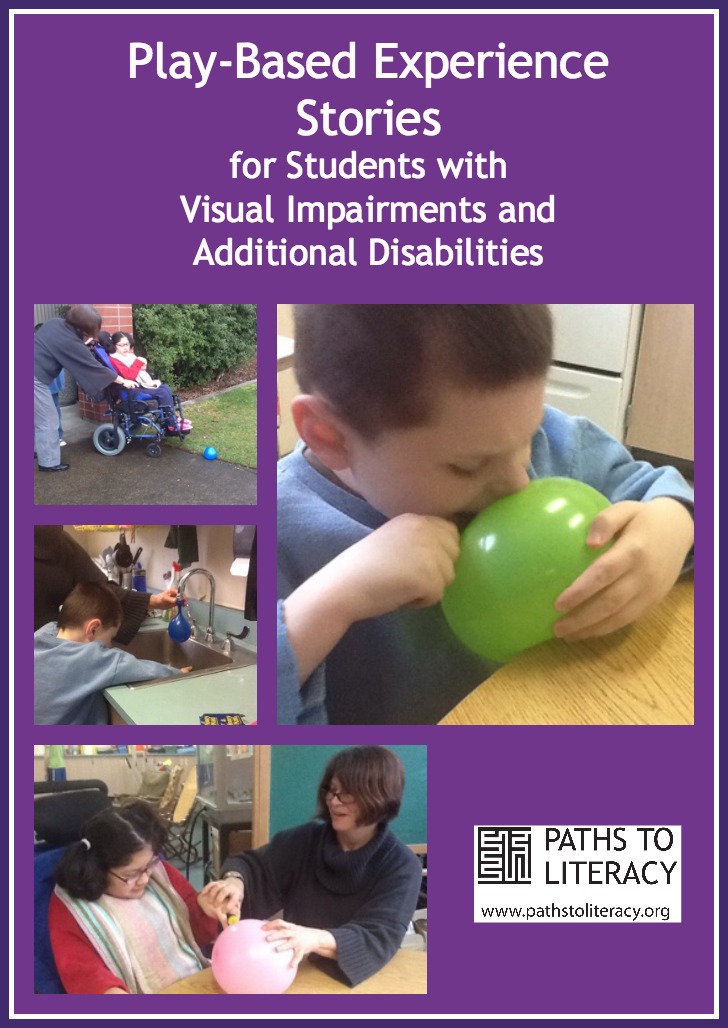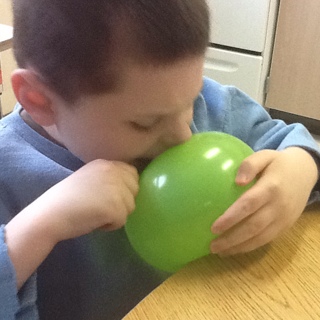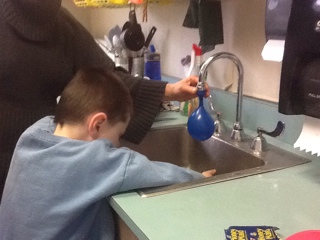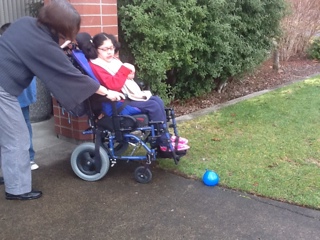Play-Based Experience Stories
Editor's Note: Please refer to the background article: Writing CAN Be Child's Play: A Collaborative Writing Program.

Students in the Writing Together Program have produced many kinds of interesting stories. I will be describing these in my blog posts and first I would like to talk about experience stories, about high-interest, play-based activities ranging from isolated sensory-motor play to pretend play. Experience stories are a widely-used practice for introducing writing to children who are blind or visually impaired, including those who are deafblind or who have multiple disabilities.
Use this menu to jump to the different sections below:
- Characteristics of Play-Based Experience Stories
- The Experience
- The Traditional Experience Story
- The Personalized Experience Story
- Tech Tip
Characteristics of Play-Based Experience Stories
- Based on student’s own activities
- Highlight part that was memorable to STUDENT. (Look for part in which student was engaged or interactive)
- Model language related to student’s symbolic or interactive play level (e.g. “together”, sound effects)
- Initially, introduce writing as natural ending to activity
- Share story with someone who wasn’t there for the experience.
- Little or no sequencing to begin with--later build in beginning, middle and end...
The Experience
Whose experience is it? Personalizing the Experience Story
In the video which follows, you will see an activity which I facilitated as a speech-language pathologist in Zane’s classroom. Zane, Lucy and Aiden were all students receiving speech therapy services. I wanted to help include Zane and Lucy in the Monday morning “share time” activity, in which the other students in the special education class talked about their weekend activities. Zane and Lucy, as nonverbal students, had not been involved since they had no way to talk about their weekends, and parents were not sending any tangible products to help represent activities. We created a context, which involved play with balloons, as a topic which could be discussed with the larger group. I worked with the more verbal students, Aiden and Kelsey, as well as the others in the class who listened to the stories to help them understand Zane’s need to learn tactually, experientially and auditorilly. I especially targeted use of hand-under-hand guidance and prompting/ guiding with objects as important concepts for the students to use and understand in their interactions with Zane. Objects and iPad overlays using the Sounding Board app were used as forms for reporting on the activity to peers. (See Tech Tip below.)
Download the transcript of the video.
The Traditional Experience Story
Aidan, Zane, And Lucy Make Water Balloons
The iPad story entitled “Aiden, Zane and Lucy Make Water Balloons” is a traditional experience story, with a focus on the roles that each of the students had in the activity. It is developed from an adult/ teacher perspective to highlight those social aspects of the activity which I wanted Zane and the other students to notice.
The Personalized Experience Story
Balloon Sounds Story
In the following session, I thought about personalizing the story for Zane. I considered his apprehension about the balloons popping and decided to highlight the breaking of balloons, and the sounds which he may learn to notice and associate with the activity, in the following experience story, so that the story would have more meaning for him.
- This is a modification of the balloon story told to highlight aspects of the experience which may be more meaningful to the totally blind student—the sounds of each part of the activity.
- Experience stories can be made more meaningful to a student if the event is described from their perspective, not just used to re-sequence the event in adult terms.
- Compare the two “adult-centric” experience stories above to the Balloon sounds story below, modified to make the story more memorable to Zane. He was much more attentive and engaged when reviewing the story below.
 |
Zane squashed the balloon. It sounded like this...
|
 |
Lucy and Linda popped the balloon. And it sounded like this... |
 |
Zane filled the balloons with water.
|
 |
Lucy rolled over the balloon and it went SPLAT!
|
Tech tip:
 The Sounding Board app on the iPad is a free app which includes auditory scanning, which can be quite helpful with students who are totally blind. The items on a page are scanned using a whisper prompt, and the student presses a switch when he hears the item he wants to select for a verbalization.
The Sounding Board app on the iPad is a free app which includes auditory scanning, which can be quite helpful with students who are totally blind. The items on a page are scanned using a whisper prompt, and the student presses a switch when he hears the item he wants to select for a verbalization. To read more about Collaborative Writing from Linda Hagood, see also Writing CAN be Child’s Play: A Collaborative Writing Program and Writing: The Forgotten Focus for Literacy and Communication Instruction. See also the Playing with Words microsite.







Comments
student-centric writing
Whose experience is it?
Play ideas
Bridging the Gap Between Sensory-Based Play & Pretend Play
Thanks for the ideas!